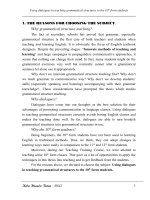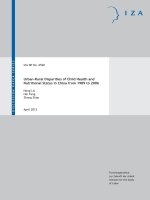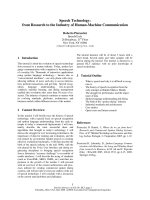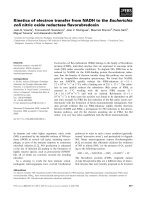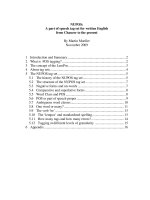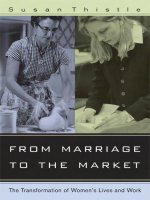Progressive Muslim Feminists in Indonesia from Pioneering to the Next Agendas
Bạn đang xem bản rút gọn của tài liệu. Xem và tải ngay bản đầy đủ của tài liệu tại đây (520.04 KB, 162 trang )
Proggresive Muslim Feminists in Indonesia from Pioneering to the Next Agendas
A thesis presented to
the faculty of
the Center for International Studies of Ohio University
In partial fulfillment
of the requirements for the degree
Master of Arts
Farid Muttaqin
June 2008
2
This thesis titled
Proggresive Muslim Feminists in Indonesia from Pioneering to the Next Agendas
by
FARID MUTTAQIN
has been approved for
the Center for International Studies by
________________________________________
Elizabeth F. Collins
Associate Professor, Classic and World Religions
________________________________________
Gene Ammarell
Director, Southeast Asian Studies
________________________________________
Drew McDaniel
Director, Center for International Studies
3
Abstract
MUTTAQIN, FARID, M.A., June 2008, Southeast Asian Studies
Progressive Muslim Feminists in Indonesia from Pioneering to the Next Agendas (162 pp)
Director of Thesis: Elizabeth F. Collins
In this paper, I explore some progressive Islamic feminist organizations and their
contributions to popularizing Islamic reform movements in Indonesia through their
popular pioneering agendas. Some pioneers of progressive Muslim feminists, such as
P3M, FK3, PUAN Amal Hayati and Rahima have killed two birds with one stone. They
made an important impact on reducing stigma against Islamic reform ideas and feminism.
Many Indonesian Muslims often consider Islamic reform movements and feminism a
Western conspiracy to destroy Islam. Progressive Muslim feminist groups’ approaches to
local Muslim scholars of pesantren (traditional Islamic boarding school) are vital in
shifting these local leaders to be focal points of Islamic reform. With more popular issues
of Islamic reform, such as reproductive rights and domestic violence, they create an
efficient step to introduce Islamic reform movements to Muslims at the grassroot level.
The feminist organizations make a crucial follow-up activity by applying feminist
perspectives in reinterpreting classical Islamic thoughts. They have produced a specific
method of Quranic interpretation (tafsir) and consequently have created a particular
Islamic thinking from the Qur’an and the Prophet Muhammad’s traditions (hadith).
Indonesian Muslim feminists have developed their methods of tafsir through direct
engagement with women’s experiences of violence. This effort is vital in spreading both
Islamic reform movements and feminism within Indonesian Muslims.
4
The growing number of progressive Muslim feminists and their crucial
contributions to popularizing Islamic reform movements in Indonesia lead conservative
Muslim groups’ responses to attack the groups. Among other challenges for the
progressive Muslim feminists are the growing Islamic shari’ah movements and the rise of
conservative Islamic expression and the rise of polygamy practice within reformist and
progressive Muslims. I make suggestions for how the progressive Islamic feminist
movement can be strengthened in its struggle against conservative Muslims, including
creating an accessible method of tafsir for more Muslim women’s groups, introducing a
multicultural approach to traditional women’s groups like majlis ta’lim, and broadening
networks by making cooperation with homosexual movement activists.
Approaved ______________________________________________________________
Elizabeth F. Collins
Associate Professor, Classic and World Religions
5
Acknowledgment
I cannot express enough gratitute to many people supported me during my study
at Ohio University. This learning experience is a part of the long process of life that
includes many contributions from a number of people. I understand, I would not be able
to reach this experience without any kind of help from them in various ways.
My parents are on the top level of deserving my appreciation. They provide me
with huge spiritual equipments that make me strong when I felt so despaired in finishing
my study. My older sister and her family are on the second stage to gain my gratitude.
The “financial instability” in their life inspired me to work hard in completing my study.
Dr. Elizabeth Fuller Collins who gave me unlimited guidance, not only in
finishing the thesis, but also during my time at Ohio University, deserves the highest
honor. She also deserves my special thanks for her tremendous job of making my writing
style more “American.” It means a lot to me since I have a dream of being a part of the
high American academic tradition. In addition, I also owe Dr. Loren Lybarger and Dr.
Risa Whitson for their great comments and thoughts on my work.
I also dedicate my honor to other professors at Ohio University, particularly Dr.
Gene Ammarell, Dr. Sholeh Quinn, Dr. William (Bill) Frederick, Dr. Harry Avelling, Dr.
Margaret Manoogia, Dr. Ronald Hunt, Dr. Haley Duschinski and Dr. Ann Tickamyer.
From them I learned a lot about how to be a mature academician in a never-ending
learning process. They greatly contributed to strengthening my open-minded perspective.
6
My friends and colleagues, with whom I shared my happiness and my blueness
and served me with a comfortable social and intellectual zone, also deserve my
acknowldgement. I need to mention some of them, yet I do not intend to exclude other
names. They are Diah Irawaty, Animesh Rathore, Lina Himawan, Sukidi Mulyadi,
Lewinna Aguskin, Sandra Nahdar, Muhammad Chozin, Rudy Sukandar, Erda Handayani,
Adrian Budiman, Nurul Pratiwi, Putut Widjanarko, Elin Driana, Song Seung Won, Keng
We Koh, Elis Z. Anis, Anis Nahrowi, Ahmad Thohir Yoga, Maryani Budiman, Sri
Murniati, Eka Sabeh, Il Sangaji, Anton Wiranata, Sony Karsono, Ezqi Suyanto, Ahmad
Fauzi, Efta and Nova Yudiarsyah, Yojo Surdjana, Daniel TA Harahap, Karmila Mahmud,
Nelly Martin, Fitria Kurniasih, Dyah Arin, Tsuroya, Merlita Anggraini, Irfana Stevanio,
Wini Pratiwi, Brian Pranata, Gugun Gunardi, Amanda Athenia, Citro Juwono, Citra
Nurmala, Eko Junor, Niken Hardiani, Adila Prasodjo, Kenny Ling, Valhan Hamdiana,
Firman Manan and Anggi, Lauri Hlavacs, Kristin Dunsky, Molly Roth, Angie Kilbane,
Lourdes Caballero, Anthony Medrano, Karla Schneider, Jeff and Pittaya Paladroi Shane,
Tim Pappa, Rick Kraince, Juli Sunderlin, Lucy Conn, Debbie Lee, Kiko Tanaka, Daisy
Wang, Sara Jones, Angela Predisik, Talinn Philips, Joan Kraynanski, Pang Pichayakul,
Hadi Ndji, Asmaa Shehata, Meghan Dudley, Christine Potts and Janice. My other
Indonesian mates as well as non-Indonesian friends and colleagues, whose names could
not be mentioned here, also deserve my sincere thanks.
I also want to express my sincere thanks to my colleagues in PUAN Amal Hayati
and other feminist organizations in Indonesia. Sinta Nuriyah, Bunda Sri Sugiri, Husein
Muhammad, Ciciek Farha, Maria Ulfah Anshor, Badriyah Fayumi, Diah Rofika,
7
Muhyiddin A. Shomad, Ruqoyyah Ma’shum, Syafiq Hasyim, Lies Marcoes-Natsir, and
Lily Purba whose dedication for enhancing women’s rights really fired my motivation
and desire in doing the same experiences and even more.
Last but not least, my study at Ohio University would not happen without the
scholarship from Ford Foundation with its International Fellowships Program (IFP). I
thank those from both IIE in New York and IIEF in Jakarta who managed my financial
needs.
Finally to women all over the world who work hard to survive in this male-
dominated planet and to those who struggle for equality among human beings, I devote
my works.
Athens, Ohio, April 21, 2008
8
Table of Content
Page
Abstract ………………………………………………………………………… 3
Acknowledgment ……………………………………………………………………… 5
Chapter 1: Introduction ………………………………………………………… … 10
A. Background ………………………………………………………………………… 10
B. Methodology .… ……………………………………………………………… 14
Chapter 2: Women and Islam:
The Foundations of Progressive Islamic Feminism ……………………………… 20
A. Arabic Traditions and the Cultural Context of the Early Islam …………………… 20
B. The Progressive Values of the Theology of Tawhid ……………………………… 24
C. The Qur’an: Revolutionary Values and Rational Interpretation ………………… 28
D. Women in the History of Islam: Marginalization and Struggle ………………… 32
1. Khadijah and ‘Aishah: Two Faces of Revolutionary Muslim Women ……… 33
a. Khadijah: Being Revolutionary in the Domestic Sphere …………….…. 34
b. ‘Aishah: Woman’s Participation in Public Roles …………………………. 38
2. Rabi’ah al-‘Adawiyah: Sufi Spirituality ………………………………………. 40
3. Muhaddithat: Women and the Tradition of Hadith ………………………… 47
E. Women’s Marginalization in Islamic History …………………………………… 53
F. Theorizing Progressive Islamic Feminism ……………………………………… 59
Chapter 3: The Dynamics of the Progressive Muslim Feminist Movement in
Indonesia from Pesantren Communities to Muslim Feminist Groups …… … … 68
A. Early Islamic Feminism in Indonesia ………………….………………………… 68
B. Feminism in Indonesia ……………………………………………………………. 71
C. From Islamic Renewal to Progressive Islamic Feminism …………………………. 72
D. The 1998 Reform Movement: Blessing or Anathema? ……………………… 75
E. Progressive Muslim Feminist Organizations ……………………………………… 78
1. Perhimpunan Pengembangan Pesantren dan Masyarakat (P3M) …………… 78
2. Forum Kajian Kitab Kuning (FK3)…………………………………… …… 84
3. PUAN Amal Hayati: Pesantren as the Center of Women’s Advocacy ……… 90
4. Rahima: Providing Academic Spaces for Muslim Women ……………………. 95
9
5. Grassroots Groups: Serving Local Communities with Women’s Advocacy
Programs …………………………………………………… ……………… 99
Chapter 4: From Challenges to New Agendas
Promoting Progressive Islamic Feminism in Indonesia ……………………… 104
A. The Rise of Islamic Shari’ah Movements ………………………………………… 104
B. Progressive Muslims and the Polygamy Debate …………………………… … 109
C. The Domestic Violence Act ………………………………………………… … 114
D. The Challenge of NGO Activism and Project-Based Programs …………………. 116
E. Providing Space for Women as Interpreters of Islam (Mufassir) ………… …… 119
F. A Multicultural Approach to Traditional Women’s Groups …………… ………. 122
G. Broadening Networks: Homosexual Movement as a Potential Partner ….………. 127
Chapter 5: Reflections on Progressive Islamic Feminism in Indonesia ………… 132
A. Colonial Rule and Islamic Feminism: The Issue of the Veil …………………… 132
B. Education for Women: The Influence of the Islamic Reform Movement in Egypt 136
C. Islamic Reform and the Involvement of Women in Politics …………….………. 141
D. The New Order and a Return to Motherhood: Women Divided …………………. 146
E. Progressive Islamic Feminism in Indonesia Today: Accomplishments
and Challenges …………………………………………………………………… 147
Bibliography ………………………………………………………………….……… 150
10
Chapter 1
Introduction
A. Background
In 1994, I enrolled in the Department of Islamic Theology and Philosophy (Ushul
al-Din) at the State Islamic University (Universitas Islam Negeri) in Jakarta. This
university is considered one of the most progressive Islamic educational institutions in
Indonesia. Harun Nasution, the rector from 1973 to 1984 and a leader of the progressive
Islamic movement in Indonesia, was noted for raising the status of the university and
giving it a reputation for progressive leadership. In my classes I encountered a tradition
of discussion and debate about Islamic theology (‘aqidah), Islamic jurisprudence (fiqh),
and the interpretation of the Qur’an and the Prophet Muhammad’s sayings (hadith). This
tradition had replaced the more authoritative method of teaching that had characterized
the previous academic culture in the university. Students were now encouraged to use
their rational capability in studying Islam. They founded their own discussion forums.
They tried to apply what they learned from “secular academic disciplines,” such as
sociology, philosophy, and anthropology, in the study of Islam. They also discussed
political issues.
This is the context in which I first encountered feminism and women’s issues. In
one forum we discussed women’s issues as defined by feminist theories and tried to
approach women’s issues in Indonesian society with critical Islamic views. In these
11
student forums we discussed domestic violence, violence in dating, polygamy, sexual
harassment, and women’s participation in politics. We organized activities, such as
training of activists, seminars, and workshops, to raise awareness of women’s rights. I
was among those who wanted to be involved in more practical action rather than just
theoretical discussions. I recognize that teachings from the Qur’an, hadith, and the work
of Muslim scholars have been used to justify or legitimate violence against women. But I
believe that Islam has great potential to uphold women’s rights in Indonesia.
In 1998 along with other students in the university, I organized a research project
to observe the influence of Islamic views and the method of teaching in Islamic
universities on female students’ attitude toward women’s issues. This research exposed
how Islam was used to create gender biases and how Islamic educational institutions
contributed to producing gender bias. This research led us to a search for critical tools to
reconstruct understanding and interpretation of Islamic teachings in order to create more
gender sensitive perspectives. I went to several activities conducted by feminist non-
governmental organizations, such as Kalyanamitra and Perhimpunan Pengembangan
Pesantren dan Masyarakat (P3M) or the Union for the Pesantren and Community
Development. In 2001, six months after graduating from the university, I became more
involved in the Islamic feminist agenda when I started working at PUAN Amal Hayati,
an Islamic feminist organization.
At PUAN Amal Hayati I began to understand the different colors of progressive
Muslim feminist groups in Indonesia. This interaction with Islam-based groups and
individuals promoting women’s rights sharpened my progressive religious vision and led
12
me to participate in several controversial issues for Muslims in Indonesia, including
homosexuality, women’s capability to lead multi-gender prayer, and criticism of
polygamy and of religious leaders who use Islamic teachings to legitimate violence. I see
Islam as a religion of justice and humanity and believe it is a distortion of Islam when
Muslims refer to Islamic teaching to legitimize their violence.
I encountered many cases of violence against women, particularly domestic
violence, when I worked at PUAN Amal Hayati. In some cases religious leaders justified
this discrimination and violence using Islamic teachings. Some kyai (pesantren leaders)
had no awareness of the gender biases they expressed in their teaching. At that time, I
came to the conclusion that the problem was religious conservatism that leads Muslim to
embrace traditional religious thinking without critical thought or awareness of actual
social problems. I believe that religious conservatism has estranged Muslims from the
tradition of critical and rational thought that made Islam the source of great civilizations
in the past.
The critique of progressive Muslim feminist groups does not only apply to
religious institutions, such as ‘ulama (Muslim clerics), but also to the Indonesian
government, which does not take steps to eliminate violence and discrimination against
women. For instance, the government of Indonesia issued Act No. 1/1974 on Marriage
and Kompilasi Hukum Islam (KHI) or the Compilation of Islamic Law that formalizes
religious misinterpretations which legitimate discrimination against women.
The Polygamy Award initiated in 2003 by Puspo Wardoyo, a restaurant
businessman with four wives, really challenged my personal religious commitment to
13
progressive Islam and shifted my orientation toward more social activism. Wardoyo used
Islam to legitimize his social insensitivity to the fact that polygamous marriages
discriminate against women. Although Wardoyo does not have academic background in
Islamic studies, he often refers to the Qur’an and hadith.
In 2004, when I was interviewed for the Ford Foundation scholarship,
Mohammad Jacob from Gadjah Mada University in Yogyakarta, challenged me with the
question: “What is your opinion if a woman chooses to accept her husband’s polygamy
based on her belief in Islam? Will you still force her to divorce or let her follow her
belief?” To be consistent I must acknowledge the freedom of people who have different
religious views. I responded to his question by saying that first I have an obligation to
convincingly explain to the woman that a polygamous marriage inevitably involves
unequal treatment of the wives and generally causes violence. Second I would explain
that religious justification of polygamy is based on a misinterpretation of Islam. If the
woman still decides to accept her husband’s polygamy, it is my obligation to honor her
decision in the name of freedom of thought. Being a progressive Muslim requires effort
to reconstruct religious teachings and respect for different religious understandings.
These experiences led me to write this thesis. Academic work on progressive
Islamic feminism in Indonesia is still very limited. This thesis reflects both my academic
efforts and field experience in progressive Islamic feminism.
14
B. Methodology
This research is based on my experience working with Islamic feminist
organizations and my study of Islam. In my reflections on Islam and progressive Islamic
feminism, I drawn on the work of Nurcholish Madjid (1939-2005), popularly known as
Cak Nur. He was educated in a traditional Islamic pesantren and went on to become a
student of Fazlur Rahman at the University of Chicago. He returned to Indonesia and
introduced a rational approach to the study of the Qur’an. I was fortunate to study under
the influence of Nurcholish Madjid at the State Islamic University in Jakarta. Along with
Harun Nasution, Madjid became the leader of a progressive Islamic renewal movement in
Indonesia. He wrote several important books explicating the rich classical heritage of
Islamic thought and showing how it could be applied to the context of contemporary
society.
Madjid began elaborating his interpretation of the Qur’an and Islamic thought
with an exploration of the dynamics of Islamic intellectual history that concluded with
the need to revitalize Islamic thinking by reviving the dynamic dialogue that had
characterized it in the past. Only in this way would Islamic teachings remain relevant to
contemporary social issues (see, for example, Madjid, 1997: 7-8). In his writing, Madjid
combines the historical legacy of Islamic sciences with modern methodological
approaches. He shows that it is important to consider the writings of both Islamic
rationalists (ahl al-‘aql), but the textualists (ahl al-naql) so that a Muslims have different
perspectives to consider when they think how to apply the teachings of Islam to modern
problems. To be a progressive Muslim scholar does not mean to turn always to rational
15
traditions, but to be aware of the need to contextualize the interpretation of Islamic
sources by considering the social conditions in which an interpretation was put forth. It is
important to emphasize that contemporary progressive interpretations of Islam are part of
a dynamic tradition of interpretation conditioned by changes in society, because
traditionalist Muslims claim that progressive Islamic thinking is an unacceptable
innovation (bid’ah). They believe that progressive Islam has no basis in the Qur’an and
constitutes a “rebellion” against the mainstream of Islamic thought and the majority of
ulama (jumhur ‘ulama).
In Islamic discourse, ijtihad (interpretation) and taqlid (conservatism/following
the model established, as in praying like the Prophet) are central concepts. Madjid
explains taqlid as “the accumulation of knowledge and experience” in the Islamic
tradition that leads a Muslim to the ultimate truth (Madjid, 1994: 342). In this context,
taqlid can be viewed as the intellectual resources that a scholar uses when he or she rests
his or her argument on the work of earlier Muslim scholars. In the process of reflection
on Islam, a Muslim with an understanding of taqlid (muqallid) also works to understand
Islam from his or her intellectual perspective (mujtahid). Ijtihad, often defined as a
rational approach to understanding Islam, must start from the Qur’an and Hadith so that
the result will have legitimacy in the eyes of Muslims. According to Madjid, taqlid and
ijtihad or the traditional and rational ways of approaching Islam are not oppositional,
rather there is a dialectical process in the context of social and historical change. To
reorient taqlid as a dynamic Islamic intellectual tradition, Madjid argues that taqlid must
be an open method, not an ideology of absolute imitation, or taqlidism, that makes
16
ancient Islamic knowledge the only standard of truth and positions the classical Muslim
scholars as absolute authorities (Madjid, 343).
Madjid highlights awareness of the historical context of every Islamic teaching in
the Qur’an. He places understanding asbab an-nuzul (the occasion of a revelation [in the
Qur’an]) of every verse in the Qur’an as essential to interpretation of the message of the
Qur’an. Knowing the historical context of a Qur’anic verse and helps a Muslim
understand the implication of the verse. Asbab an-nuzul is also important in applying the
verse to different social situations (Madjid, 1994: 25). In emphasizing asbab an-nuzul,
that is, the social issue important at the time of the revelation, as essential in the
interpretation of the Qur’an, Madjid points out that all interpretations are part of a
tradition of Islamic teaching relevant to different social-historical situations.
Madjid argues that the history of Islamic thought proves that the process of ijtihad
is an open-ended, never-ending process. Earlier constructions of Islamic thought from
classical scholars are important foundational knowledge as Islamic teachings are
recontextualized for the contemporary world. Following Madjid’s method, I view
progressive Islamic feminism in Indonesia as situated in a context of intellectual
continuity with Islamic traditions from the past. Islamic feminism in Indonesia does not
exist in an historical vacuum. Muslim feminists have become aware of the need to
reinterpret Islamic teaching in support of developing gender justice in contemporary
Indonesian society. This is a result of social-academic interaction with heterogeneous
historical currents within Islam and with currents in non-Islamic social-cultural entities.
17
Therefore, the diverse colors of Islamic feminisms emerge in Indonesia in response to
historical and social change.
Madjid often says that we have to confidently believe in the validity of our
interpretation of Islamic teachings, but we must realize that “our understanding may be
true, but other opinions may be not wrong.” There is no need to make an absolute claim
of truth. The belief that our knowledge is true does not mean to absolutely claim that the
others’ interpretations are unacceptable innovation. Instead, Madjid calls for freedom of
thought in Islamic discourse.
In this thesis, I question some interpretations of the Qur’an that Muslim groups
have used to legitimate discrimination against women because they do not take the
cultural and historical context into account in understanding these verses. Some
progressive Muslim feminists in Indonesia that I will examine in this work have been
developing arguments to justify a reinterpretation of classical Islamic teaching about
women and interpretations of the Qur’an that enhance women’s rights. They have
adopted Fazlur Rahman’s method of interpretation, which I also use in this thesis.
For Muslims, the Qur’an “is the divine word literally revealed to the Prophet
Muhammad (between 710 and 732 CE) in a sense in which probably no other religious
documents is held to be so” (Rahman, 1982: 2). However, it should be understood that
the 22 years of revelation of the Qur’an and the prophethood of Muhammad was a period
when “all kinds of decisions on policy in peace and in war, on legal and moral issues in
private and public life were made in the face of actual situations; thus the Qur’an had
from the time of its revelation a practical and political application” (Ibid). In this context
18
Rahman emphasizes that “Muhammad’s prophetic career was likewise geared toward the
moral improvement” (Ibid). I conclude that the text of the Qur’an is absolutely divine, but
its application to Muslim society must be considered in the context of the dynamics of
social and historical change. Rahman calls this method of interpretation “the method of
Qur’anic hermeneutics” (Rahman, 1982: 4).
In this hermeneutic method, interpretation consists of two movements, “from the
present to Qur’anic times, then back to the present” (Rahman, 5). In this regard, instead
of focusing on the text of the Qur’an, social context should be at the center of the
interpretation. Social context changes so a dynamic interpretation of relevant passages in
the Qur’an is necessary. Interpretation of the Qur’an should be an open dialogical process
in which many Muslims can participate in various ways. The gates of ijtihad should
always be open. Then Islamic history will be guided by a process of deliberation, a never-
ending effort toward the highest Truth that only belongs to God.
Rahman emphasizes that “Every critique or modification of a tradition involves a
consciousness of what is being criticized or rejected and hence, to that extent, self
awareness” (Rahman 1982, 10). Progressive exploration of Islamic teachings is not
simply the application of a rational approach to interpretation, but, more importantly, it
involves self awareness in the process of implementing the Divine mission of justice and
humanity. The standard of validity of Qur’anic interpretation is not only its “accuracy” in
understanding the text of the Qur’an, but also the ability of an interpretation to support
the needs of social justice and humanity. The various paths of interpretation of the Qur’an
19
share the goal of seeking ultimate Truth (al-haqq), but none is a final determination of
Truth, rather the dialogical process renews each generation in their search for Truth.
20
Chapter 2
Women and Islam:
The Foundations of Progressive Islamic Feminism
In this chapter I begin by describing the patriarchal culture of Arabia at the time
of the Prophet. I then show how the Qur’an and the Prophet Muhammad reformed the
social-cultural conditions that determined women’s existence within society. I show that
Islamic theology provides core concepts for a progressive Islamic feminism, but in the
centuries following the death of the Prophet, women were marginalized by patriarchal
Islamic institutions that were established. Nevertheless, remarkable Muslim women
emerged who have been an inspiration to modern Muslim feminists.
A. Arabic Traditions and the Cultural Context of the Early Islam
Arabic societies have been stereotyped as barbarian, inward-looking, oppressive
and conservative. These stereotypes shaped the thinking of some Orientalists, who
claimed the same attributes for Muslims. Some Orientalists did not make a clear
distinction between Arabic culture and Islamic traditions. This notion can be found, for
example, in Gustav Le Bon’s works The World of Islamic Civilization written in 1884.
Understanding Arab traditions before the revelation of Islam is important to show the role
of this religion in carrying progressive ideas, including the liberation of women from any
type of oppression. Arab societies have inherited several high traditions of the world
21
civilization. However, in this context, I want to delve into certain Arab cultural
characteristics that have had great influence in coloring the tenets of Islam on women.
My emphasis on very specific Arab customs is not meant to devalue Arab traditions, but
rather to
utrid
ze the dynamics and continuity of ideas within Arab society where
Islam was first developed.
In Arab societies patriarchal and male-oriented values and tribalism were
reinforced by war and conflict as powerful men played strategic roles, such as
commanders and soldiers while women and children were often victims. Women were
regarded as the property of conflicting groups. The loosing group had to provide women
from their tribe as war prisoners, and the winners would use the women prisoners as
sexual slaves. Thus, ‘Umar ibn Khattab, one of the closest companions of the Prophet
Muhammad and the second Caliph, killed his daughter in order to prevent her capture and
enslavement. The tradition of tribal war in Arabic societies also perpetuated the
phenomena of polygamy and concubines.
Ancient Arab society had a rich poetry tradition. Poems were used to express
honor and beauty, and karamah (hospitality, graciousness) was a core idea in the poetry
tradition of Arabs. But contests of honor were waged through poetry (Hourani, 1991: 12).
Montgomery Watt (1953: 24 as quoted by Brown, 2004: 14) describes some ideals as
expressed in the poetry of early Arabs, such as “Muruwwa[h], manliness, which
encompasses all that will display and protect a man’s honor: corage, loyalty, generosity,
sexual prowess.” This can be traced in al-mu’allaqat (suspended poems) that were hung
in the Ka’bah (the House of God) to show one’s power over others.
22
The social structure of the Arab society was a system of tribes or clans
(shu’ubiyyah), which vied for honor and status. “All over Arabia the various tribes had
their own sanctuaries, idols and sacred stones” (Hawting, 1999: 24). A leader of a tribe
was “a heroic figure whose life and teachings would establish law” (Sowell, 2004: 17).
Living in a desert environment, the Arabs were a pastoral and nomadic people. This
frequently led to clashes and warfare. According to Sowell, without a communal justice
system to keep order, individuals were entirely dependent upon their tribe. “A man
without a tribe could be killed or enslaved with impunity” (Sowell, 2004: 15). In the
Qur’an God’s voice is not revealed in a vacuum. God supports His followers and urges
them to counter-attack those who terrorize them and cause fear (see, for example, al-
Baqarah (2): 190–194, al-Hajj (22): 39-40, and al-Shura (42): 39-42). However, God also
says, “O mankind! We created you from a male and a female and made you into nations
and tribes (al-Hujurat (49): 13), and this verse is followed by the words lita’arafu (“So
you may know and honor each other”). With these words, God encouraged people toward
dialogue and mutual understanding. This is just one example of how early Islam
interacted with and dealt with problems caused by the traditions of Arab societies. There
are many passages in the Qur’an and hadith directing Muslims to prioritize dialogue. In a
hadith transmitted by al-Bukhari and Muslim, it is told that the Prophet said, “Help your
brothers who become victims of violence and your brothers who perpetrate violence.”
His companions asked, “How can we help perpetrators of violence?” The Prophet
answered, “Help them to stop their behavior.”
23
The tradition of warfare led to people placing a high value on masculinity and
patriarchal values. Islamic teachings in the early period followed Arab societies in
glorifying and magnifying masculine and patriarchal values. Nevertheless, women’s
rights are treated in the Qur’an. For instance, polygamy was limited to four wives and a
man was required to treat all his wives justly (al-Nisa’ (4): 3). The Qur’an includes a
chapter called al-Nisa’ (The Women). The discourse on leadership (qiwamah) in this
chapter (al-Nisa’ (4): 4) acknowledges that women have a voice in political discussions
(mushawarah) along with men. The Qur’an is not meant as a complete document with
concrete directions; but rather, the Qur’an displays examples and symbols that require
rational and contextual approaches in order to achieve its progressive and revolutionary
meanings for the purpose of upholding women’s rights. This is another example of the
importance of cultural context in the teachings of the Qur’an and the direction given for
the development of a better and more just social order.
With this insight, we can view Islamic teachings as a part of cultural
transformation instead of a religious teaching that had no relationship with the existing
social situation. As Farid Essack asserts, the Qur’an was revealed based on the demands
of a real social situations as a proposed framework of social change (Essack, 1997: 54).
He continues, “[the Qur’an] portrays a picture of a Deity actively engaged in the affairs
of this world of humankind” and “God would thus not speak into a vacuum nor would He
convey a message in one” (Essack, 2002: 121 and 122). As a cultural transformation,
Islamic teaching is not final, but rather requires a never-ending cultural process toward
the most appropriation application of the teaching in a particular social situation. The
24
Islamic response to Arab society is best viewed as an early initiative instead of a final
unchangeable teaching. Through the Qur’an and the Prophet Muhammad’s hadith God
gives particular teachings as a theological foundation leading human beings toward the
“final destination” (husn al-khatimah). Islamic teachings are contextual, historical, and
express a grand vision of social reform. Hence, it is necessary to actively renew our
religious and spiritual understanding in order to develop Islamic teachings that contribute
to the needs of society. In this way, we can maintain the progressive and revolutionary
values of Islam.
Tadrij, literally the principle of gradualism, means that the Qur’an was proposed
in a step-by-step basis instead of a frontal confrontation with established social traditions.
With tadrij, God means the Qur’an as having no final dogmas about a subject of
discourse; rather, it is open to every renewal endeavor.
B. The Progressive Values of the Theology of Tawhid
Tawhid is the most basic principle of Islamic theology. Literally, tawhid, from
wahhada yuwahhidu, means “an action of declaring God (Allah) to be one” (Davutoglu,
1994: 47) or “the belief that God is one inalienable divinity” (‘Abduh, 1966: 29). With
tawhid, a Muslim declares her or himself free from believing in any form of divine power
other than Allah: there is no god, but Allah (La ilaha illa Allah). Furthermore, ‘Abduh
explains that embracing tawhid, Muslims believe that “from Him alone all being derives
and in Him alone every purpose comes to its term.” Hence, “unity was the great aim of
the mission of the Prophet Muhammad” (‘Abduh, Ibid., 1). This implies that
25
egalitarianism, justice and solidarity are important values in Islamic theology. It is
impossible to build unity among people and establish the best society (khayru ummah)
without upholding the values of equality, justice and solidarity.
The theological concept of tawhid was a moral value that unified all members of
society in one belief as an important foundation for social solidarity. In Mecca, Lapidus
points out, monotheism was a radical idea since Mecca was one of the most complex and
heterogeneous places in Arabia (Lapidus, 2002: 17). The Arab people were polytheistic
and believed in paganism, dynamism and animism (Lapidus, 15). Since the Arab people
defined their gods in terms of the power they had, in the society there was a tendency
toward authoritarianism and individualism. Hence, tawhid was a revolutionary theology.
Tawhid became a crucial prophetic tool in criticizing common social behavior in Arab
societies, particularly individualism, hedonism, authoritarianism, and violence.
In addition to engendering the concept of human unity, tawhid also includes the
concept of resurrection and that each person will be held responsible for their ‘amal
(behaviors) in their life. Those who spent their lifetime with tawhid and good behavior
(al-ladzina amanu wa ‘amilu al-salihah) will be rewarded by heaven, and those who
passed their lives with bad behavior (al-‘amal al-sayyiah) will be punished by hellfire. In
this context, the idea of tawhid played a vital role in developing social order within
Arabic societies. With the belief that Allah is the only God who will hold people
responsible, people will be more disciplined to control their lives. On one hand, tawhid
discouraged powerful groups to control their power, and on the other hand, tawhid
empowered weak groups of people who lived under the control of others. Instead of

